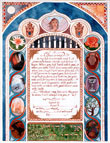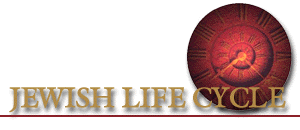 THE KETUBAH - The Jewish Marriage Contract
THE KETUBAH - The Jewish Marriage Contract
 The ketubah is a traditional Jewish art form that dates back to the early Middle Ages in Europe, Asia and the Middle East. Ketubot (Hebrew plural form of the word) were made on parchment or paper with watercolor or tempera paints, ink, and metallic leaves and powders. The art consists of calligraphy and decorative borders or symbolic illustrations.
The ketubah is a traditional Jewish art form that dates back to the early Middle Ages in Europe, Asia and the Middle East. Ketubot (Hebrew plural form of the word) were made on parchment or paper with watercolor or tempera paints, ink, and metallic leaves and powders. The art consists of calligraphy and decorative borders or symbolic illustrations.
The Hebrew word "Ketubah" means literally, "It is written." Originally scripted in Aramaic, the document was developed to protect brides from destitution. At that time, there were no civil laws regulating marriage, and according to Jewish law, a husband could ask for a divorce but a wife could not. Husbands had the opportunity and the responsibility to work for pay whereas wives worked in the home. The ketubah specified the groom's financial responsibility to the bride both during the marriage and in the event of its demise should the husband die or seek a divorce.
The industrial revolution ushered in a decline of all handcrafts including manuscript illumination, which fell out of use. In recent years, however, the art of the ketubah is enjoying renewed popularity both within and outside the Jewish community. New updated texts including Reform Jewish, renewal of vows and universal wedding vows have transformed the ketubah in some circles into a romantic reminder to the married couple of the promises they've made and the love they share.
The ketubah is meant to be framed and hung above the marriage bed. Its beauty and symbolism are a talisman to safeguard the sanctity of the marriage.
It is customary for the bride and groom to sign the ketubah in a separate ceremony before the huppah ceremony (the actual wedding ceremony under the wedding canopy). It is done with just the witnesses, bride, groom and rabbi involved and occasionally all of the guests are invited to watch.
Click on the links below to see different Ketubot texts:



